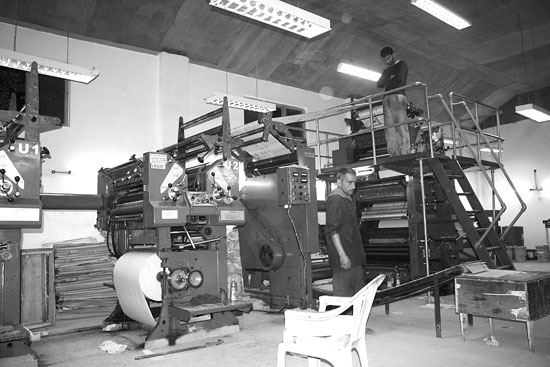The two-decade turmoil has adversely impacted most business in Kashmir, but for the media industry it provided a boost. Haroon Mirani takes a look at the sector.

If nothing else, media has grown tremendously in the last two decades in Kashmir – a long way from the small, literally boring sector of pre-87 to the big and vibrant one of today. It is buzzing with journalists who give international, world class reporters a run for their money.
Ghulam Hassan Kaloo, president of Kashmir Press Association (KPA) a body representing majority of newspapers in Kashmir says that media has seen tremendous growth in both quality and quantity. “The industry is also providing jobs to lots of people,” said Kaloo whose KPA has 63 valley based newspapers as its members. With the exception of big guns like Greater Kashmir and Rising Kashmir, KPA represents most of the news papers including Etalaat and Kashmir Times.
Kaloo says that each newspaper has around 15 persons associated with it, “Thus making it a huge job provider.” Even some small newspapers are run by five people, its contribution to the sector cannot be denied.
Prior to 1990 Kashmir had three main newspapers including the congress party-owned Khidmat. The lone English daily Kashmir Times was published from Jammu.
Last year Minister for Law and Parliamentary Affairs, Ali Mohammad Sagar informed the Legislative Council that 127 newspapers in English and 240 newspapers in Urdu are published from the State. Of the English newspapers, 39 are published from Srinagar and 88 from Jammu while as of the Urdu newspapers, 142 are published from Srinagar and 98 from Jammu. “About Rs 4.60 crore were paid on account of advertisement charges to the English newspapers in the State during 2008-09 while about Rs 3.52 crore were paid for the purpose to the Urdu newspapers in Jammu and Kashmir during this period,” he further said.
The advertising industry which feeds the media is also growing. “We used to get Rs 27 per centimetre of ad from government and now that rate has been increased to Rs 38 per centimetre,” said Kaloo. “The annual budget is also being increased by 40 per cent from the current Rs 6 crore per year.”
It is set to further fuel the boom in media.
Many of these four hundreds odd newspapers are Litho type and published in black and white and their circulation limited to Information department and few other offices.
Of all these newspapers Greater Kashmir (GK) has been the biggest success story. Starting as a weekly, GK group as it is known by its acronym comprises of the flagship English Daily and the Urdu daily Kashmir Uzma.
“Ours was the first English weekly which started its publication in 1988,” said Arshad Hussain Kaloo, Associate Editor Greater Kashmir. “At present we employ around 150 people in editorial, reporting as well as printing press.”
GK’s reporting base is spread from New Delhi to Islamabad and Muzaffarabad, with more in the offing.
The circulation department of the newspapers has also grown a lot. “At present there are around 500 persons involved in distribution and circulation of various newspapers in Kashmir,” says Javid Ahmad Marketing Manager Kashmir Valley, Amar Ujala newspaper.
The boom in newspapers has contributed to the introduction to newer technologies in printing in Kashmir. GK brought its first 3C printing press in 2003. Soon the colour printing was introduced in Kashmir and as of now there are nine top-line printing presses in the valley.
ELECTRONIC BOOM
The electronic boom that the subcontinent saw in recent years translated into a number of bureaus in Kashmir. Picking up from the global satellite television boom, Kashmir has seen its version too. The last few years have witnessed the emergence and growth of local cable channels, managed by the cable service operators. The trend started with the success of SEN channel in 2005. “We started as an experiment with just three people comprising of reporter, cameraman and editor,” said Syed Tajammul, editor in chief of SEN group of channels. “People liked it and soon we grew tremendously.”
SEN at present operates three channels SEN channel, SEN Kashir Channel and Awaz channel. They employ around 100 people in various sections.
Cable sector has also seen its hardships before getting recognized. “When we started, people looked down at us and they used to tease that cablewala’s have come,” remembers Tajammul. “But now that mindset has changed and people themselves call us whenever there is a function, be it religious, separatist or from government side.”
After the momentum set by SEN, at present there are around ten channels operating in Srinagar. Dozens of more such channels operate in district headquarters, catering to their local audience.
The channel boom would have gone unhindered but for the government restrictions. After the 2008 land















